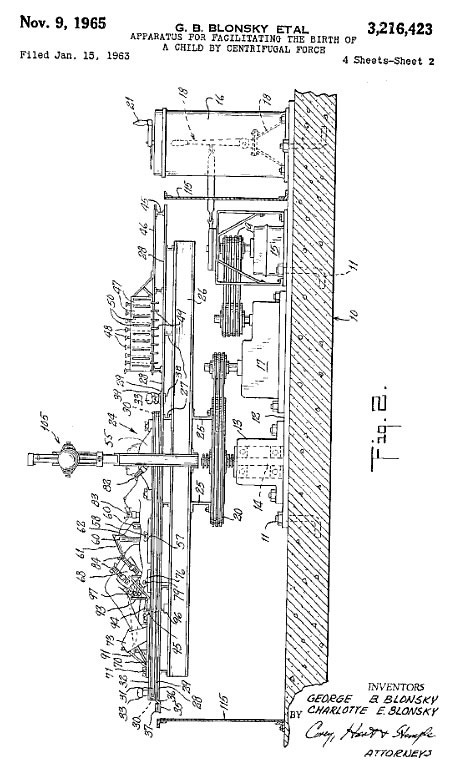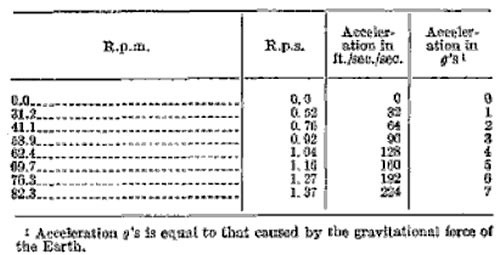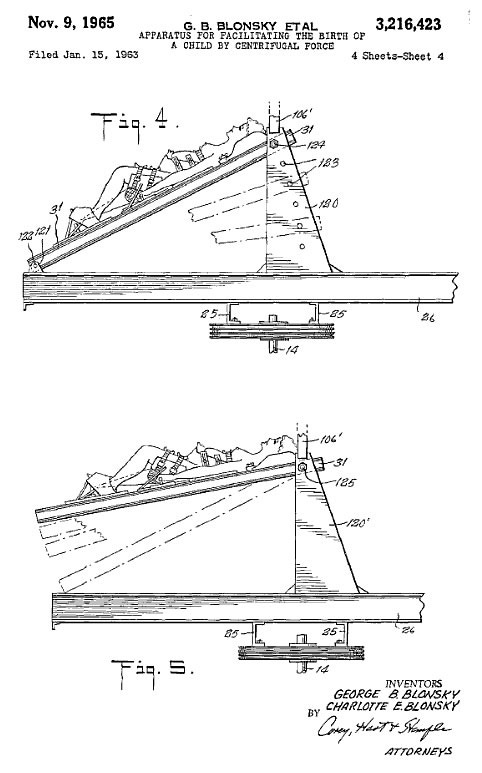
When they came up with this idea, the Blonskys must’ve said to themselves: “Yes, giving birth to you child is a special event in your life, but you know what would make it even more special? Turning it into a midway ride.”

From the abstract for the patent:
It is known that due to natural anatomical conditions, the fetus needs the application of considerable propelling force to enable it to push aside the constricting vaginal walls, to overcome the friction of the uteral and vaginal surfaces and to counteract the atmospheric pressure opposing the emergence of the child. In the case of a woman who has a fully developed muscular system and has had ample physical exertion all through the pregnancy, as is common with all more primitive peoples, nature provides all the necessary equipment and power have to a normal and quick delivery. This is not the case however with more civilized women who often do not have the opportunity to develop the muscles needed in confinement.
It is the primary purpose of the present invention to provide an apparatus which will assist the under-equipped by creating a gentle, evenly distributed, properly directed, precision-controlled force that acts in unison with and supplements her own efforts.

Another excerpt from the patent:
When the gynecologist decides that the most time for childbirth has arrived, he instructs the operator to start the machine. When the operator moves the controller handle 21 from zero position the motor 15 is started and through the speed reducer 17 and the associated set of sheaves and belts including the sheaves 19 and 20, the I-beam frame 26 and everything supported thereby are revolved horizontally about the vertical axis of shaft 14. As the operator moves the controller handle 21 to feed more and more current to the motor 15, the rotational speed of the machine progressively increases and so does the centrifugal force. The relationship of of rotation and of acceleration at three feet distance from the center of rotation is illustrated by the following table:

The physician’s estimate of how much of this centrifugal force will be needed to assist the mother in achieving the birth of the child and the maximum g‘s that can be used with safety on the particular patient are decided upon before the operation. During the operation, the operator gradually speeds up the machine to the predetermined force which is expected to produce the birth of the child and if such force does not accomplish this he does not exceed it unless the physician decides to go the higher g‘s. He cannot, however, go beyond the maximum g’s for which the machine has been set without causing the governor 105 to shut down the machine. When in the operation of the machine, the operator reaches a rate of rotation at which the combination of pressures produced both by the created centrifugal force and by the mother exceed the childbirth resisting forces (friction and constriction), the movement of the fetus occurs and the child is delivered into the net 88. While in the net, the child is still subjected to the action of centrifugal force and is caused by such force to firmly press against the elastic bottom of the net 88. As the elastic cables 89 and the net give somewhat to this force which is equal to the weight of the child multiplied by the number of g‘s it is subjected to, the cotton wad 97 in the net is pressed by the child against the switch lever 93 which is actuated to cut the power from the motor 15 and may be utilized to activate an electric bell, announcing the event. The operator then applies the handbrake 18 to gently bring the machine to a complete stop. Thereupon, the stretcher with the mother on it is detached from the machine and transported to her room.

I’m imagining the draftsman commissioned to draw these diagrams saying “You want me to draw what?” There’s potential for some hardcore Japanese anime in this invention.
For the full patent-y goodness, see here.













